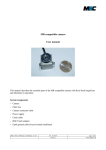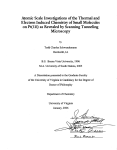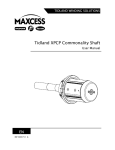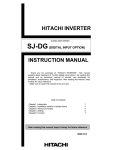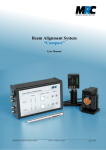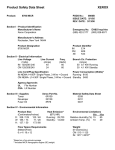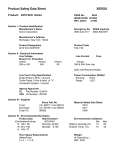Download Options and accessories "Compact"
Transcript
Description of options, upgrades and accessories for the laser beam stabilization system “Compact” The basic configuration of the Compact laser beam stabilization system is fully equipped for stabilization tasks in laser machines or laboratory set-ups. It provides all required functions and parts (controller, detector/s, mirror holders and actuators, cables, etc.). However, for specific installations or lasers we offer a couple of adaptations or additional modules which further help to optimize the system for relevant parameters. These adaptations and modules are described in this user manual. Some of these have to be integrated in the Compact system before the delivery. Others can be ordered as additional upgrades or accessories without the need for integration. Contents 1. Controller modifications..............................................................................................................2 1.1. Sample&hold circuit (“ADDA“) to fix the laser beam during laser off times.................................2 1.2. Adaptation for low repetition rates..................................................................................................2 1.3. Adjustment of the proportional element (P factor) of the control loop............................................3 2. Interfaces, additional inputs and outputs.....................................................................................3 2.1. External activation...........................................................................................................................3 2.2. Remote setting of the P factors........................................................................................................4 2.3. Direct drive of Piezo actuators („Drive Actuator“).........................................................................4 2.4. Voltage offset inputs to move the target position on PSDs (“Adjust-in”).......................................5 2.5. Intensity outputs at controller (e.g. in case that UV- or vacuum-PSDs are used)............................5 2.6. Range outputs for monitoring applied Piezo voltages.....................................................................6 2.7. Set-box for adjustment of target position on PSD...........................................................................6 3. Detectors......................................................................................................................................6 3.1. Wide intensity detector: 4-quadrant diode with wide intensity range..............................................6 3.2. UV 4-quadrant diodes.....................................................................................................................7 3.3. IR 4-quadrant diodes.......................................................................................................................7 3.4. PSDs................................................................................................................................................7 4. Mirror mounts..............................................................................................................................8 4.1. Adapters for mirror dimensions of 0.5'', 1.5'' and 2''........................................................................8 4.2. Mirror mounts for 3'' and 4'' mirrors ...............................................................................................9 5. Vacuum adaptions.......................................................................................................................9 6. Optical components.....................................................................................................................9 6.1. Optical filters...................................................................................................................................9 6.2. Mirrors, lenses.................................................................................................................................9 7. Cables, other cable lengths........................................................................................................10 8. Shutter........................................................................................................................................10 9. Contact.......................................................................................................................................11 Compact beam stabilization / Options and accessories version 4 – September 07, 2015 page 1 of 11 1. Controller modifications 1.1. Sample&hold circuit (“ADDA“) to fix the laser beam during laser off times In some applications with the laser beam stabilization the laser beam might be switched on and off during the operation. In laser off times there is no intensity on the detectors and hence no control signal for the closed-loop controller. In such situations, the Compact beam stabilization without additional measures will drive the Piezo-driven steering mirrors into a defined position, the so-called zero position (please refer to the Compact system's user manual for more information). Once the laser is switched on again the stabilization will start its operation from this position. The zero position should have been used for the first adjustment of the optical set-up. That is why this is usually a good starting point for the stabilization. However, in cases of large drifts of the laser beam in the overall set-up, the zero position can – at least in the long term – strongly deviate from the required steering position. Switching on the laser after a time interval without laser beam and the resuming of the stabilization can therefore lead to an undesired initial spike of the beam position. With the additional sample & hold circuit in the Compact beam stabilization system the positions of the steering mirrors can be fixed for an arbitrarily long time interval without control signal or laser intensity on the detectors. In that way it is possible to start the control-loop after switching on the laser not f rom the zero position but from that latest stabilized position. The additional sample & hold (S&H) circuit is of special advantage for the following applications: – In all systems where the laser must be switched on and off several times during the laser process, e.g. in material processing machines. Even if the system has been drifted away from its basic adjustment, the beam position will start from the last stabilized position after resuming of the control loop. In this way an oscillation of the beam from the “zero position” to the desired position is eliminated and a potential faulty processing of the work piece is prohibited. – In systems with a very large distance between the steering mirrors and the detectors. These set ups bear the risk that a drift changes the adjustment in that way, that the laser beam will no longer hit the detector in uncontrolled intervals. Thus, it can happen, that the beam stabilization can not catch the beam on the detectors after a resuming of the stabilization when the laser was switched off for some time. – In systems with very low repetition rates or lasers with irregular intervals of laser pulses (or pulse packages). If the S&H circuit of the beam stabilization is triggered for each laser pulse the beam position will get closer to the desired position with each pulse. The name “ADDA” is derived from the functional aspect that the actuators' drive signals are first AD converted and digitally stored before they are subsequently DA converted again and fed to the amplifiers of the mirror actuators. You can find more information about this module in a separate user manual. 1.2. Adaptation for low repetition rates For lasers with low repetition rates (e.g. 10 … 300 Hz) the detector electronics can be modified in order to maintain a position signal in the time gaps between two laser pulses. Notes: • • Due to the low repetition rate the controller is then also optimized to low bandwidths. For lasers with even lower repetition rates we recommend our ADDA module (section 1.1). Compact beam stabilization / Options and accessories version 4 – September 07, 2015 page 2 of 11 1.3. Adjustment of the proportional element (P factor) of the control loop In the standard set-up, the proportional and integral elements of the control loop lead to a very stable performance of the beam stabilization system with desired bandwidths. That is why no user interactions are required to adjust the control loop. However, in specific cases the user might wish to adjust the control loop for his application. Such cases can be set-ups with rather long arm lengths or the requirement to achieve the highest possible bandwidth of the system. Since the control loop is mainly affected by the proportional element, we can offer a direct access to the proportional element by means of potentiometers at the side panel of the controller box. This can be done separately for each stage of the system. In order to optimize the performance, we recommend to start with a small P factor and operate the system in this stable configuration. Then you can increase the P factor by simply turning the potentiometer in clockwise direction, until the system reaches its stabilization limits and starts to oscillate. Notes: • • The optimal P factors of stage 1 and 2 can differ. If the distances of the optical components, the beam diameter, the laser intensity, or other laser data change, the P factor of the overall system might also change. We also offer an interface for the remote setting of the P factor. This is described in section 2.2. 2. Interfaces, additional inputs and outputs Beside the inputs for the detectors and the outputs to the actuators the basic configuration of the Compact beam stabilization provides the following outputs: • • Status signal (see user manual of Compact system) Position signals x and y of each detector (analog voltage signal -5 to +5 V) Other signal outputs or inputs can be provided as options. Note: In some cases the arrangement of the connectors on the side panels have to be changed. 2.1. External activation The external activation enables the change of the operation state of the beam stabilization system with an external signal. There are three operation states. The specification of the control signal is as follows: Signal Voltage range (Level: 5V TTL) H (high) 2.4 – 5.0 V L (low) 0.0 – 0.8 V Z (high impedance or not connected) Compact beam stabilization / Options and accessories Controller status Start Stop Manual mode according to selection on front panel version 4 – September 07, 2015 Reaction of Active LED on off on/off page 3 of 11 The external activation can be independently applied for stage 1 and stage 2 of the stabilization system. For this purpose, two LEMO connector plugs (series 00) are embedded on the right connector panel of the controller box. The inputs are marked as “Ext” and are next to the respective detector inputs. 2.2. Remote setting of the P factors The system can be equipped with analog inputs for a remote adjustment of the proportional elements (P factors, see section 1.3). The remote adjustment connectors are then integrated into the controller box in addition to the potentiometers. Whenever a voltage signal is applied to the remote adjustment, the potentiometers are ineffective. The input voltages can be set between 0 and 5 V. The remote adjustment connectors can also be used as outputs to read out the currently voltages as set by the potentiometers. Specification: Input/output voltage range: Connector: Cable set: 0 … +5 V LEMO 00 series * LEMO 00 -> BNC for each stage, length 2m * The configuration of the connectors at the controller box and of the cables can be changed depending on the selection of additional options. Note: The remote adjustment has to be driven with a low impedance voltage source (<= 1kOhm), whereas the read-out drives only high impedance terminations (>= 1 MOhm). 2.3. Direct drive of Piezo actuators („Drive Actuator“) As an option for the direct drive of the Piezo actuators (i.e. without feedback from the detectors) we can implement additional input channels to the controller. It is then possible to drive the actuators with an external control signal. This option makes use of the integrated 4-channel high-voltage amplifier of the system. Specification: Inputs: Outputs / to Piezo actuator: Output impedance: Power supply: Integrated 140V voltage converter 4 signal inputs (LEMO 00) on side panel, +/-5V 4 voltage outputs on side panel, LEMO 0S series, 9V to 120V 110 Ohm@1kHz, designed for high capacitive load 12V, 2A power supply The input signal will be converted to a high-voltage signal which is fed to the Piezos. Notes: • The specification of the voltage range for the PKS / PSH Piezo actuators is -20V to +130V. The maximum tilt for the actuators is Actuator type PKS PSH Compact beam stabilization / Options and accessories Range > 1 mrad (0.5 mrad in each direction) > 2 mrad (1.0 mrad in each direction) version 4 – September 07, 2015 page 4 of 11 We have specified the voltages to values of 9V to 120V for the valid range of the green range LEDs (max. range 0-130V). • There is a non-linearity in both, the characteristics of the Piezos and the amplifiers. Therefore the signal will not be fully proportional to the input signal. If you need a precise and absolute position of the steering mirrors (without the control-loop which usually gives the position feedback) you should carry out a calibration of the angles versus voltages. • It is also possible that the x and y axes of the same Piezo actuator vary strongly. 2.4. Voltage offset inputs to move the target position on PSDs (“Adjust-in”) As described in section 3.4 the measurement principle of PSDs allows to move the target position on the detector by means of a voltage offset. For this purpose we can implement additional inputs for the x and y axes of both, stage 1 and stage 2. These inputs can be used to change the still stabilized beam position by an external source. The input voltage range of these inputs is -5V … +5V. Figure 1: Left panel with four additional “Adj-in” inputs for x and y position of two PSDs Figure 1 shows the modified side panel of the controller box with additional “Adj-in” inputs for the voltage offset. Note: The position vs. voltage characteristics of a PSD is usually not linear. Therefore, a calibration should be performed if the target shall be moved on a desired path. 2.5. Intensity outputs at controller (e.g. in case that UV- or vacuum-PSDs are used) Since the UV- and vacuum-versions of the PSD detectors do not have the intensity level displays we can add additional intensity voltage outputs at the controller box. Figure 2 shows these outputs marked with “Int” close to the detector inputs. In this figure, the standard 4QD input connectors are labelled as input connectors for PSDs. Compact beam stabilization / Options and accessories version 4 – September 07, 2015 page 5 of 11 Figure 2: Right panel with PSD input connectors and intensity output connectors 2.6. Range outputs for monitoring applied Piezo voltages In some applications it can be helpful to know the applied voltage ranges of the Piezos, e.g. to see whether or not the tilting range of the Piezos (and therefore the voltage range) is at its limits. If the Piezo actuators are combined with additional motorized mounts in order to enlarge the overall tilting range, the Piezo voltage can be used as a trigger to drive the motors. 2.7. Set-box for adjustment of target position on PSD The set-box was developed as a simple tool for demonstration purposes and laboratory applications. It is an electronic box which offers potentiometers for x and y to manually adjust the target positions and outputs to the Piezo driver electronics (e.g. “Adjust In”, see section 2.4). In an additional configuration it can be equipped with inputs for external signals so that an external signal from a signal generator can be added. Note: The box can be equipped with x and y position and intensity displays. Please also ask for appropriate cables. 3. Detectors 3.1. Wide intensity detector: 4-quadrant diode with wide intensity range In some applications the laser intensity is varied or modulated over wide ranges. The performance of the wide intensity detector is fully independent of the intensity. The signal amplification automatically adapts to changing powers. The power can vary by a factor of >1,000 without the need of exchanging the optical filters. External signals or user interactions are not required. Since the signal-to-noise ratio is not changed, the stabilization system reaches the maximum resolution over the entire intensity range. The function of the power level display is unchanged compared to the description in the Compact system's user manual, i.e. it can still be used to support the selection of the optical filters. In contrast, the potentiometer as described in section 4.5. of the user manual is omitted. Note: Due to the wide intensity range it is possible to detect even lowest laser powers. Therefore, depending on the selection of the optical filters, the detection signal can be affected by ambient light. Compact beam stabilization / Options and accessories version 4 – September 07, 2015 page 6 of 11 3.2. UV 4-quadrant diodes For lasers with UV wavelengths we offer two 4-quadrant-diodes with different sensitive areas and the following specs: Specification: Wavelength range: Sensitive area: UV 4-quadrant diode – Type 1 190-1,000 nm 3x3 mm2 UV 4-quadrant diode – Type 2 5-1,000 nm 10x10 mm2 Figure 3 shows a photo of the sensor side of the Type 1 UV 4QD. Figure 3: UV 4-quadrant diode with sensitive area of 3x3 mm2 3.3. IR 4-quadrant diodes For laser with infrared wavelengths we offer a 4-quadrant diode with the following specs: Specification: Wavelength range: Sensitive area: IR 4-quadrant diode (Germanium) 800-1,800 nm Ø = 5 mm Note: We also offer a 4-quadrant detector for CO2 lasers at 10.6 µm. Such lasers are often operated with powers in the range of several kW and large and heavy-weight mirrors. That is why the integration of the stabilization system can require additional measures for mounting the actuators and leaking a portion of the laser power to the detectors. 3.4. PSDs As an alternative to our standard 4-quadrant diodes we offer PSDs (position sensitive device) for visible and for UV wavelengths with the following specs: Specification: Wavelength range: Sensitive area: VIS PSD 400-1,100 nm 9x9 mm2 Compact beam stabilization / Options and accessories UV PSD 200-1,100 nm 10x10 mm2 version 4 – September 07, 2015 page 7 of 11 Compared to the 4-quadrant diodes the PSDs have a continuous measurement area. This leads to two possible advantages: 1) The sensitive area is not divided by a gap. Therefore, the PSD can be used in case of very small beam diameters or focused beams. 2) Whereas with the 4-quadrant diodes the target point is usually defined by their cent re, in case of the PSDs any other point on the sensitive area can be chosen as a target point. Notes: • • • • The UV-PSDs do not have the position and intensity displays at the housing as the standard 4quadrant diodes have. If we equip the beam stabilization with PSDs but no further measures, we use the electronic center (defined by a voltage of 0V for x and y position) as the target position. The position vs. voltage characteristics of a PSD is usually not linear. Therefore, a calibration should be performed if the target shall be moved on a desired path. The UV PSD can not be used for pulsed lasers with repetition rates below 1 kHz. Please consider the additional input and output options of sections 2.4 and 2.5 which can further improve the functionality of stabilization systems with PSDs. Applications: If you use the PSDs instead of 4-quadrant diodes, the position detection is not limited to the centre as it is with 4-quadrant diodes. By adding a voltage to the signal of the PSD the target position where the laser beam shall hit the PSD can be moved. Still, the beam stabilization will provide full stabilization of the beam direction, but the direction itself can be manipulated. The external signal can be applied to the system via the “Adjust in” functionality described in section 2.4. This feature can be used for different applications, e.g.: • Place the PSDs before the laser is finally adjusted. Then adjust the laser and read-out the target position. Feed back the voltage for the new target position. The system will then stabilize the laser beam onto this position. • Place the PSDs before the laser is finally adjusted. Then move the position on the detectors until you have the optimal laser adjustment. • Move the laser beam to different points (or along a pattern) by moving the beam position on the PSDs. You can vary the laser beam direction with highest resolution and it is still stabilized. Note: A simple tool to move the target position by potentiometers is shown in section 2.7. 4. Mirror mounts 4.1. Adapters for mirror dimensions of 0.5'', 1.5'' and 2'' Our standard mirror mounts PKS and PSH have holders for 1'' mirrors. The PKS mirror mount is also available with a holder for 0.5'' mirrors. The PSH mount can be combined with adapters for larger mirror dimensions of 1.5'' and 2''. The left photo in figure 4 shows the mount with a 2'' mirror. Compact beam stabilization / Options and accessories version 4 – September 07, 2015 page 8 of 11 4.2. Mirror mounts for 3'' and 4'' mirrors Our beam stabilization systems can also drive mirrors with larger dimensions. The right photo in figure 4 shows an example. Please be aware that the bandwidths which can be achieved with such mirrors is lower than with standard components. Figure 4: PSH mirror mount with a 2'' mirror held by an adapter (left) and 4'' mirror actuator (right) 5. Vacuum adaptions Both, the detectors and the actuators can be adapted for use in vacuum. In case of the actuators, this is possible for vacuum pressures down to 10-11 mbar. But this is an extreme value. In case you intend to place some components in vacuum please let us know the conditions so that we can discuss and offer the required measures with you. Some measures (choice of materials and cables, sealing) are mainly focussed to avoid degassing and depend on the pressure. Other measures are important to protect the components themselves. Note: The controller itself should not be placed in vacuum. 6. Optical components 6.1. Optical filters We usually offer to integrate a pair of optical filters in front of each sensor. The filters have a size of 11.9x11.9 mm2 and fit into the provided slot in the detector housing. 6.2. Mirrors, lenses We can also offer appropriate filters or lenses for your set-up. However, since we do not produce optical components by our own we do not have any price advantages compared to our customers. Compact beam stabilization / Options and accessories version 4 – September 07, 2015 page 9 of 11 7. Cables, other cable lengths The standard delivery of a Compact laser beam stabilization system includes all required cables to set up the system and to read out the positions. These are: Cable set (included in standard delivery) Detector → Controller Actuator → Controller Actuator → Controller (Elongation) x-y-position cable (Lemo → BNC) quantity length 2 2 4 m (including the 3xMXC/power → Lemo adapter cable) PKS: 1.5 m (directly mounted to Piezo element) PSH: 1.2 m (directly mounted to Piezo element) 1 pair for 10m 1 actuator 2 2m In addition to these cables we can also offer additional cables or cables with other lengths. The following table shows some examples. Other available cables and/or lengths (examples) Elongation cables for 4QD detectors (Lemo → Lemo) Elongation cables for actuators (Lemo → Lemo) Cables for external activation (Lemo → BNC) Cables to connect the intensity ouput (Lemo → BNC) Typical lengths 1 m … 25 m 1 m … 25 m 2m 2m If you do not find the cable you need please do not hesitate to contact us. Since we assemble various cables in-house we can customize almost any cable and cable length. 8. Shutter The laser shutter system Beamblock was especially developed for the use with our laser beam stabilization systems. It fulfils the safety function to block the laser beam in such cases where the stabilization system isn´t capable to align the laser beam due to exceeding beam deviations. For this task the status signal “OK” of the stabilization system is used to control the laser shutter system externally. The shutter system consists of a laser shutter and a shutter controller that allows to drive the shutter in three different modes of operation: • confirm mode • external mode • manual mode Thus the shutter can be controlled automatically by other devices or semi-manually with a safety confirmation by the user. Additionally it is possible for the user to open and close the shutter directly in the manual mode. The input for external signals is prepared for standard TTL-levels, which allows the shutter system to be compatible to most other controllers (e.g. laser interlock or computer controlled devices). Figure 5 shows photos of the laser shutter and the shutter controller. Compact beam stabilization / Options and accessories version 4 – September 07, 2015 page 10 of 11 Laser beam Figure 5: Laser shutter (left) and shutter controller (right) You can find more information about this module in a separate user manual. 9. Contact MRC Systems GmbH Hans-Bunte-Str. 10 D-69123 Heidelberg Germany Phone: Fax: Website: E-mail: +49-(0)6221/13803-00 +49-(0)6221/13803-01 www.mrc-systems.de [email protected] Compact beam stabilization / Options and accessories version 4 – September 07, 2015 page 11 of 11











